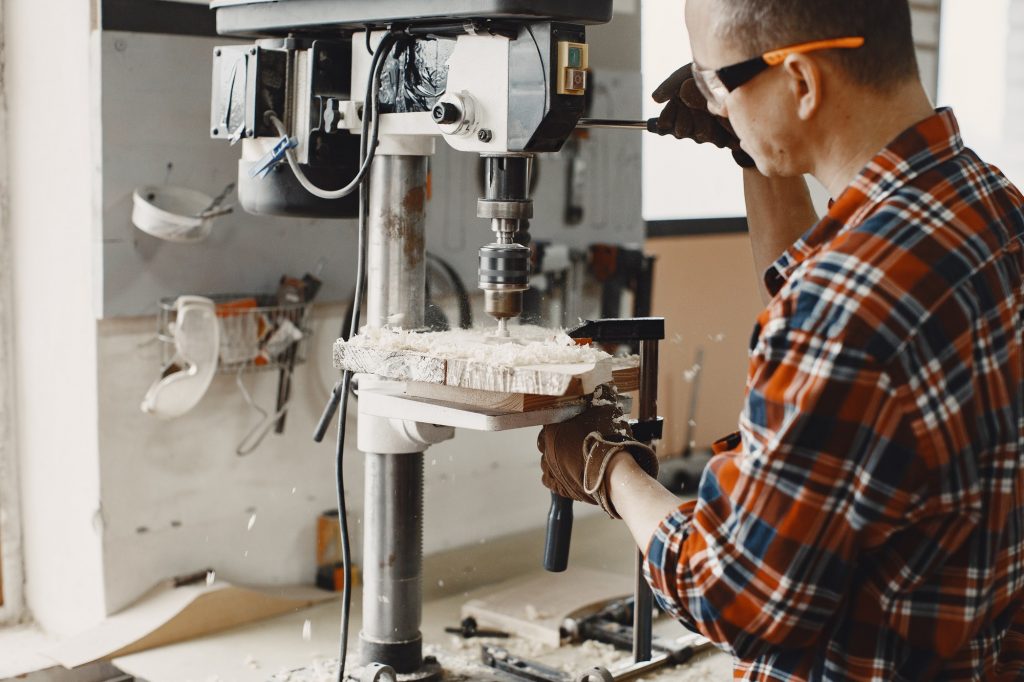Machining processes like turning and milling are fundamental to modern manufacturing, enabling the creation of precise and complex components. These techniques are indispensable across industries such as aerospace, automotive, and construction, where precision and efficiency are critical. While both methods share the goal of shaping materials, they differ in their approach and applications. This article focuses on the difference between turning and milling.
What is milling?
Milling is a machining process used for machine tool manufacturing. It uses rotary cutters to remove material from a workpiece, shaping it into a desired shape and form. Performed on a milling machine, this process involves moving the workpiece in various directions while the cutting tool rotates, enabling precise removal of material to create features like slots, holes, and complex profiles. Milling operations are versatile, accommodating various materials such as metals, plastics, and wood, and are used in industries like aerospace, automotive, and construction. With advancements in computer numerical control (CNC) machining technology, modern milling offers high precision and efficiency, making it indispensable for manufacturing parts with intricate geometries and tight tolerances.
Types of milling
- Face Milling: This milling process is widely used to machine flat surfaces perpendicular to the cutting tool’s axis. By utilising the cutter’s face, it ensures efficient material removal and a smooth finish, making it an essential step in preparing surfaces for subsequent operations or achieving a polished result on structural components.
- End Milling: The versatility of this method lies in its ability to create intricate features such as pockets, contours, and slots using the edges and the tip of the cutting tool. It is a crucial process for industries requiring high precision, such as mould-making or aerospace, where detailed and complex geometries are necessary, often achieved through CNC machining.
- Peripheral Milling: With the cutting action concentrated along the sides of the tool, this process is ideal for machining the outer edges of a workpiece. It is frequently employed to shape edges, create grooves, or cut deep slots with excellent accuracy, often serving mechanical assembly requirements.
- Slot Milling: Slot milling is a process used to create narrow grooves or channels in materials, with precision. This type of milling is commonly used for making keyways, rails, or mechanical components. Specially designed milling cutters ensure that the slot dimensions meet exact specifications for proper component fitting.
- Profile Milling: This process is used to produce complex contours and intricate shapes for applications requiring customisation, such as automotive body parts or turbine blades. It allows for machining both functional and aesthetic features with a high degree of precision.
- Angular Milling: Angular milling is a process used to create angled features on a workpiece surface. This process employs specially designed cutters to achieve beveled edges, V-grooves, or other specific angles. It is commonly applied in the creation of molds, fixtures, or specialised components requiring precise geometry.
- Form Milling: Custom-shaped cutters are the cornerstone of this process, enabling the production of specific patterns or geometries on a workpiece. It is especially effective for machining irregular surfaces such as gears, cams, or decorative components, ensuring consistent and accurate results.
- Straddle Milling: This method uses multiple cutters on a single arbour to simultaneously machine both sides of a workpiece. It is highly efficient for creating parallel surfaces, making it a go-to technique for producing symmetrical parts like shafts or spacer bars in fewer passes.
- Gang Milling: By arranging multiple cutters on a single arbour, this process enables the machining of several features in one operation. It is particularly advantageous for mass production, allowing for the simultaneous creation of grooves, slots, or profiles, saving time and improving productivity.
What is turning?
Turning is a machine tool machining process that involves rotating a workpiece while a cutting tool removes material to shape it into a precise form, typically cylindrical. Performed on a lathe, this process allows creating various shapes, including shafts, cones, and threads, with exceptional accuracy. It is essential in manufacturing industries to produce rotationally symmetric components and achieve smooth finishes. With the integration of CNC technology, turning has evolved to handle complex geometries and ensure consistent quality, making it a cornerstone of modern CNC machining.
Types of turning
- Straight Turning: This process focuses on uniformly reducing the workpiece’s diameter along its length to achieve a precise cylindrical shape. It is commonly used in manufacturing components such as shafts and axles, where uniformity is critical for performance and fit. Straight turning is a fundamental operation that sets the foundation for additional machining processes.
- Taper Turning: By gradually reducing the diameter of the workpiece along its axis, taper turning creates conical shapes. This is essential for components like spindles or adapters, where a tapered fit ensures tight assembly or alignment. Different techniques, such as setting the compound rest or using a taper attachment, allow for flexibility in producing various taper angles.
- Facing: Facing produces a smooth, flat surface on the end of a workpiece, perpendicular to its rotational axis. This operation is often the first step in machining to prepare the workpiece for further operations. It ensures a clean, precise surface that is critical for applications requiring proper alignment and assembly.
- Thread Turning: This process involves cutting threads on the outer or inner surface of the workpiece, enabling it to be fastened with other components. Thread turning requires precise synchronization of the lathe’s rotation and the cutting tool’s movement, making it a key operation in producing bolts, screws, and threaded fittings.
- Grooving: Cutting narrow grooves into a workpiece allows for the placement of rings, seals, or snap fits, which are integral in mechanical systems. Grooving can also create decorative features or serve as preparation for subsequent operations like threading or parting-off.
- Parting-Off: This operation separates a finished part from the remaining stock material, often at the final stage of machining. It ensures a clean cut and is widely used in mass production when multiple parts are machined from a single bar of material.
- Contour Turning: By following a predefined profile, contour turning produces complex, non-linear shapes. This process is invaluable for creating aesthetically or functionally detailed components, such as turbine blades or ergonomic handles, requiring precise control over the cutting tool’s path.
- Boring: Boring is used to enlarge or refine pre-drilled holes, ensuring precise internal diameters and surface finishes. This operation is essential for creating accurate bores in cylinders, engine parts, or other components where tight tolerances are necessary for functionality.
- Drilling on a Lathe: Combining the lathe’s rotation with a stationary cutting tool, this method creates or refines holes in the center of the workpiece. It is often used to start holes that will be further enlarged through boring or threading, ensuring proper alignment and accuracy.
- Internal Turning: Machining the internal surfaces of a workpiece, such as bores or cavities, allows for the creation of features like cylindrical or tapered holes. Internal turning is critical for components like bushings, bearings, or hollow shafts, requiring specialised tooling and precise control in the CNC turning process.
The difference between milling and turning
The primary difference between milling and turning lies in the motion of the cutting tool and the workpiece during the machining process.
In milling, the cutting tool rotates while the workpiece remains stationary or moves linearly to bring different areas into contact with the tool. This process is used to create flat surfaces, slots, and complex geometries, making it ideal for machining parts with intricate designs or multiple features.
In turning, the workpiece rotates while the cutting tool remains stationary or moves along predefined paths. This method is best suited for creating cylindrical or rotationally symmetric components, such as shafts, bushings, or threads.
The choice between milling and turning depends on the shape of the workpiece and the required features. Milling is more versatile for complex shapes and planar features, while turning is more efficient for producing round or tubular parts. Both processes are complementary and are often used together in manufacturing to produce intricate and precise components.
Conclusion
Milling and turning serve as cornerstones of machining for machine tool manufacturing. Each of the processes offer unique advantages for shaping materials into functional components. Milling excels in creating complex geometries and planar features, while turning is ideal for producing rotationally symmetric parts. Together, these processes complement each other, meeting diverse manufacturing requirements with precision and efficiency. By mastering these machining techniques, industries can achieve the quality, versatility, and productivity needed to thrive in competitive markets.










